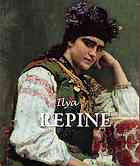
Ilya Repin PDF
Preview Ilya Repin
IIllyyaa RREEPPIINN BO Repin 4C.qxp 3/18/2011 9:04 AM Page 2 Author: Grigori Sternin and Jelena Kirillina Layout: Baseline Co. Ltd 61A-63A Vo Van Tan Street 4th Floor District 3, Ho Chi Minh City Vietnam © Confidential Concepts, worldwide, USA © Parkstone Press International, New York, USA All rights reserved. No part of this publication may be reproduced or adapted without the permission of the copyright holder, throughout the world. Unless otherwise specified, copyright on the works reproduced lies with the respective photographers, artists, heirs or estates. Despite intensive research, it has not always been possible to establish copyright ownership. Where this is the case, we would appreciate notification. ISBN: 978-1-78042-733-1 BO Repin 4C.qxp 3/18/2011 9:04 AM Page 3 Grigori Sternin and Jelena Kirillina Ilya Repin BO Repin 4C.qxp 3/18/2011 9:04 AM Page 4 BO Repin 4C.qxp 3/18/2011 9:04 AM Page 5 Contents Introduction 7 The Creative World of Repin 13 His Works 129 Biography 181 Notes 193 Index 194 BO Repin 4C.qxp 3/22/2011 3:30 PM Page 6 BO Repin 4C.qxp 3/22/2011 8:57 AM Page 7 Introduction D espite his rich imaginative endowment, a poignant sense of reality is the birthright of each and every Russian. Those restless wanderers who started from Galicia and the upper Dnieper River, who founded Kiev, Novgorod the Great, and Moscow, and settled in the fertile basin of the Volga, were not theorists. The intrepid traders who in turn pushed across the Urals and penetrated the silent forests and frozen marshes of Siberia were not impelled by abstract ideas, or by the pious frenzy of the Crusaders, for instance, but by simple reasons of racial and tribal pressure. From the outset, in brief, the Rus’ has been brought face to face with the most severe conditions, external and internal. He has always been a subject and a sufferer. Now overrun by the ruthless hordes of the Great Khan, and sterilized by the ritual of Byzantine priests, the true Slavic spirit has had little scope for individual development. When the Mongol yoke was, at length, broken by the Grand Prince Vladimir, the situation remained much as before. Oppression still existed, only it came from within, not from without. The people no longer paid tribute to the khan; they bowed to the tsar now, a creature almost as alien and as autocratic. Down to the present time, in fact, matters have continued with but slight alleviation. Though there were liberator tsars as well as demonic tyrants on the imperial throne, progress has remained dubious and intermittent. The beneficent humanity of Alexander II was succeeded by the drastic reactionary policy of von Plehve and Pobedonostsev. Each step forward seems to have been offset by a corresponding step backward. The Tatar spearman gave way to the Cossack with his knout. And the blue banner of Genghis Khan has been replaced by the red badge of revolution and a reversion to the most sinister forms of despotism. Of all epochs in the spiritual evolution of Russia, the most inspiring from the standpoint of nationalism are the memorable years that followed the liberation of the serfs in 1861. It was at this period that the great, passionate publicist Chernyshevsky, turning from Teutonic abstraction to Russian actuality, pronounced the dictum that “Beauty is Life”, and it was at this time also that came into being the aspiring organization known as Zemlya i Volya(Land and Freedom). The atmosphere was charged with hope and anticipation. Radiant ideas of progress permeated all classes of society. On every side were signs of regeneration, of a vast political and social awakening. In the comparatively tardy Self-Portrait, 1878. development of contemporary cultural expression in Russia, the novel and the play Oil on canvas, 69.5 x 49.6 cm. preceded the graphic and plastic arts. For long periods the painter was crushed beneath The Russian Museum, St Petersburg. archaic formalism and sterile academic precedent, just as in the broader relations of life, On a Turf Bench, 1876. all healthy, spontaneous initiative was repressed by influences wholly artificial and Oil on canvas, 36 x 56 cm. foreign. While it is a matter of record that Gogol actually paved the way for such masters The Russian Museum, St Petersburg. 7 BO Repin 4C.qxp 3/18/2011 9:04 AM Page 8 BO Repin 4C.qxp 3/18/2011 9:04 AM Page 9 BO Repin 4C.qxp 3/18/2011 9:05 AM Page 10 of domestic genre as Sternberg, Fedotov, and Perov and that Turgenev was among the earliest to appreciate the elegiac beauty of native Russian landscape, it matters little which came first, and which after. The chief point is that from this period onward each strove to depict with increasing fidelity not only the actual physiognomy of the country itself, but that confused and questing human equation that lay just at hand waiting to be understood and interpreted. With that passion for absolutism so typical of the Slavic mind, it is scant wonder that the emancipation of art should follow rapidly upon the liberation of the serfs. On November 9, Summer Landscape in the Kursk 1863, under the magnetic leadership of Kramskoi, thirteen of the ablest students of the Province, 1881. Imperial Academy of Fine Arts rebelled against soulless formalism, left the institution, and Oil on cardboard, 14 x 20 cm. The Tretyakov State Gallery, Moscow. formed themselves into an independent body. The little band of aspirants struggled 10
